At Transform’s People, Culture, and the Future of Work series, Brandon Sammut, Chief People Officer at Zapier, shared his perspective on how AI and no-code automation are reshaping organizations. From the rise of “citizen developers” to redefining workforce strategies with bots alongside people, Sammut outlined the opportunities—and responsibilities—leaders face as the future of talent rapidly evolves.
Key Takeaways — Brandon Sammut at Transform
- Citizen Developers are here — anyone can now build software without coding skills.
- AI is both a fear and an advantage — transparency and training are essential to make it a people-first strategy.
- The 4 Bs Framework — build, buy, borrow, or bot—leaders must stack-rank their choices when solving capability gaps.
- Culture matters — safety, openness, and visibility help employees experiment and grow with AI.
- The future is now — where employees spend the next 2–3 years will define their next 20.
Citizen Developers and Human Potential
Sammut sees the rise of the citizen developer as the most significant trend in the future of work. With today’s tools, anyone in an organization—finance, HR, operations—can build software solutions without knowing how to code.
For Zapier, this began 14 years ago with no-code automation. But now, the tools are cheaper, easier, and more powerful than ever, opening up vast new possibilities for how work gets done.
Sammut illustrated the point with a personal story: building a Pac-Man game with dragons alongside his 8-year-old son, entirely through natural language prompts. The exercise wasn’t just fun—it was a real-world example of experimentation, iteration, and learning through technology.
Leading Through Fear and Uncertainty
The rise of AI has created anxiety among employees about job security. At Zapier, Sammut and his team addressed this head-on by declaring a “code red” in March 2023, just six months after ChatGPT launched.
The move wasn’t universally popular—some found it alarmist—but it forced the company to act with urgency. Tactics included:
- Creating Slack channels for use cases, questions, and peer learning.
- Designating power users as mentors to onboard the rest of the company.
- Making hack weeks AI-focused, with enterprise-grade security and IT guardrails.
The key lesson: leaders must be transparent. Even if the answer is “we don’t know yet,” teams deserve clarity on how leadership is approaching the impact of AI on jobs and careers.
The 4 Bs: A Framework for Workforce Decisions
To navigate strategy in the AI era, Sammut introduced Zapier’s decision-making framework: the 4 Bs.
- Build — develop talent or solutions internally.
- Buy — hire new talent or purchase external solutions.
- Borrow — flex talent across functions and seasons.
- Bot — leverage automation and AI.
Zapier now requires leaders to justify backfills and consider all four Bs before adding headcount. Sammut urges organizations to stack-rank these options so employees understand how and why decisions are made—creating transparency, trust, and alignment.
Recognition, Culture, and Safe Experimentation
Instead of monetary rewards, Zapier recognizes AI and automation champions with visibility and recognition. Demo channels, hack week awards, and even the company-wide summit showcase how contributions from any team—not just engineering—advance innovation.
This recognition reinforces a culture where employees feel safe to try, fail, and grow with AI tools.
A Bold Outlook: Careers Are Being Defined Now
Sammut’s boldest prediction? The next two to three years will shape the next 20 years of employees’ careers. Companies that can provide rocket-fuel growth opportunities—through AI adoption, inclusive cultures, and people-first strategies—will emerge as talent magnets.
For leaders, the challenge is heavy but urgent: invest now in employee growth and adaptability, or risk falling behind to leaner, faster competitors using the latest tools.
Final Thought
Sammut’s message is clear: the future of talent isn’t just about people or technology—it’s about both, together. Leaders who embrace AI while fostering transparency, culture, and human growth will define the next era of work.
As he put it, every company must decide: will we build, buy, borrow—or bot?

